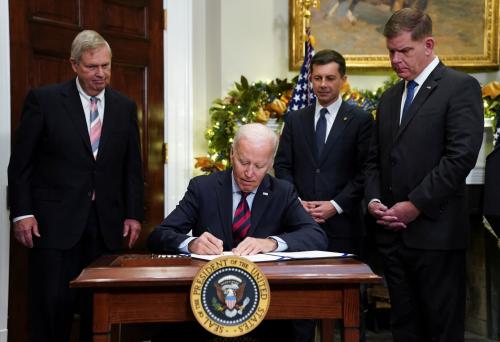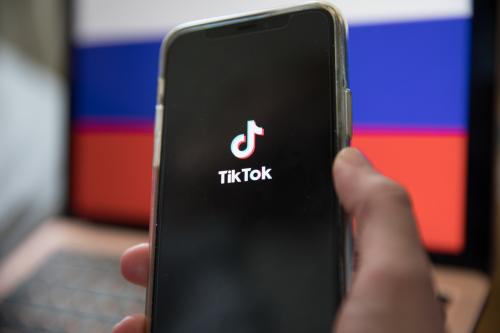Before it adjourned in the early morning hours of Saturday, December 18, the Senate pushed out a remarkable 87 confirmations in its final week this year. The week’s tally marked the Senate’s most productive spurt since President Biden took office. On the agency side, the Senate confirmed forty-four ambassadors or special representatives with ambassadorial rank (one was also confirmed as the alternate representative to the United Nations); ten assistant administrators or secretaries; two undersecretaries; two independent regulatory commissioners (one was confirmed separately as chair); one U.S. attorney; one agency general counsel, seven members (and one chair) of various councils, endowments, and boards; and three other officials. (The appointments version of “The Twelve Days of Christmas.”) On the judicial side, the Senate approved a dozen judges to the federal bench—two to courts of appeals and ten to district courts—as well as two non-Article III judges to the Court of Federal Claims. Seventy confirmations passed on voice votes; the remaining seventeen recorded the votes of individual senators. Not one was achieved through unanimous consent.
Democrats have rightly celebrated the pace of judicial confirmations. President Biden has barreled past his recent predecessors, matching President Reagan’s first year on federal judges. But critics have largely lamented the depth of agency vacancies. Even with the recent spurt of confirmations, of President Biden’s 683 formal nominations, over 300—overwhelmingly to agency posts—did not get confirmed by the year’s end (fourteen were withdrawn earlier). Many of those are key positions being tracked by the Washington Post and Partnership for Public Service (171 of the 803 tracked positions have announced nominees whose files are sitting with the Senate). Over 100 agency nominations (along with nineteen lifetime judicial nominations) will be returned to the White House in the early days of 2022.
In addition to the Senate’s delays, there are missing nominations. A recent study determined that the last three completed administrations (George W. Bush, Obama, and Trump) did not make, on average, a single nomination in their first two years for nearly thirty percent of Senate-confirmed agency positions that they were supposed to fill. While President Trump had the worst record, the figure was over one-quarter for President Obama. Today, of the 803 key agency positions tracked by the Washington Post and Partnership for Public Service, nearly 150 positions lack an announced nominee (another twenty-two announced nominations haven’t yet been submitted to the Senate). As of early December, for example, President Biden had filled only one-third of U.S. attorney positions with his picks; some districts have pending nominees but many do not.
I confirm here that the “judges good, agencies bad” narrative about the Biden administration’s record to date is true but also add some complexities to the story. After providing a quick recap of nominations and confirmations at the eleven-month mark, I discuss some reasons for the current White House and Senate delays in filling key agency positions. While good governance commentators (myself included) often bemoan the consequences of vacancies, some delays may be justified—for example, as a necessary price to pay of moving beyond the typical in-and-outer pool of potential appointees. I also explain why the difficulty in obtaining unanimous consent will have real consequences early next year when the Senate will return many pending nominations and briefly summarize the status of some pending reform proposals.
Eleven-Month Mark
Using data from www.congress.gov, Table 1 summarizes nominations and confirmations in the first eleven months of recent administrations (ending December 19). Numbers in parentheses include totals through the end of December in a past administration’s first year.[1]
Table 1: Nominations and Confirmations in First Eleven Months of Recent Administrations
| Administration | Nominations | Confirmations | ||
| Agencies | Article III Courts | Agencies | Article III Courts | |
| Biden | 612 | 71 | 325 | 40 |
| Trump | 503 (505) | 58 (68) | 266 (304) | 19 (19) |
| Obama | 640 (662) | 30 (34) | 420 (454) | 11 (13) |
| George W. Bush | 744 (757) | 105 (105) | 488 (498) | 27 (28) |
| Clinton | 658 (658) | 48 (48) | 483 (483) | 28 (28) |
The Democrats are justifiably ebullient on judges (although while Republicans saw less than half of President Biden’s tally in President Trump’s first year, they did confirm a Supreme Court justice). President Biden leads his recent predecessors on judicial nominations and confirmations. The complaints about agency leadership are equally justified. At the end of 2021, President Biden will be just ahead of President Trump on confirmed appointees in federal agencies, but President Trump explicitly dismissed formal appointments, preferring to rely on his “actings”. Compared to President Obama, President Biden is slightly behind on agency nominations and considerably behind on confirmations, despite more favorable Senate rules (on votes needed to move a nomination to a confirmation vote and on debate time). President Obama’s administration should not serve as the bellwether, however. President George W. Bush, who had a slow start to transition planning, had submitted about a hundred more agency nominations to the Senate than his successor by the end of 2001.
Delays by the White House
On its first day, the Biden administration got off to a quick start on nominations, but it then slowed (with some discrete bursts that comparatively lifted up its statistics for a few days). Six months in, the Biden administration was considerably behind the George W. Bush and Obama administrations. In recent months, the pace has picked up.
Where to cast blame? It did take three weeks after the election for the General Services Administration to provide resources (including background checks) to the Biden-Harris transition team. Some administration officials cited this delay as a primary excuse for Biden’s slow progress on nominations in his early months. But selections were not just three weeks behind.
Others have complained about the Presidential Personnel Office (PPO). In line with several conversations I have had with people in and outside the administration, POLITICO reported this summer about “frustration” with PPO’s “hiring pace.” PPO’s director, Cathy Russell, left this month to direct UNICEF. She did last longer than President Obama’s first PPO director, who moved on from staffing plum agency jobs to taking one as ambassador to South Africa six months after inauguration. Some agency heads also clashed with PPO, slowing selections. Knowing confirmations take time, PPO did smartly fill lower-level positions to get default acting officials in place while the formal process churned.
And some delays are worthy ones. The Biden administration has made real strides in diversifying agency leadership. We have the first Black secretary of defense, first female secretary of the treasury, the first woman as chair of the Federal Communications Commission, and the first openly transgender person confirmed by the Senate, to name just a few “firsts”. According to research by Kathryn Dunn Tenpas, at the 300-day mark, women made up half of the 140 confirmed appointees to the fifteen cabinet departments, and nearly forty percent were persons of color. These are marked increases from previous administrations, including President Obama’s, which had itself improved on its predecessors’ records. Finding leaders outside the largely white and male pool of former appointees (the “in-and-outers”) takes time, as does the processing of potential nominees with limited or no government paper trails.
Delays by the Senate
A major chokepoint in staffing agency positions this year is the Senate. To be sure, time is scarce for all of us, including the Senate, and agency picks often lose out to legislation and judicial nominees. This year, Congress enacted the $1 trillion bipartisan Infrastructure Investment and Jobs Act, and negotiations on Biden’s Build Back Better Act, which recently failed (on the current terms), consumed members’ time. Democrats have also decided to focus on judges, with considerable success. “[W]ith Schumer reserving prized floor time for confirming Biden’s judiciary picks over other priorities,” the Democrats set records on judicial confirmations to the lower courts.
Delays in agency confirmations did not rest entirely, however, on these priorities of the White House and Senate. Despite changes to Senate rules in 2013 that decreased the number of votes required to move a nomination to a confirmation vote and in 2019 to cut the hours of debate time, other mechanisms remain to hamstring the process. While not unique to this year, individual Republican senators targeted many agency picks in 2021. Senator Ted Cruz, for example, blocked for months every nomination to the State Department over a Russia to Germany gas pipeline (after the White House dropped sanctions on Russia). Senator Josh Hawley promised to obstruct national security nominees because of how the administration pulled out of Afghanistan. Senator Tom Cotton blocked all U.S. attorney nominees from blue states until Democratic Senator Dick Durbin apologized for interrupting him during Vanita Gupta’s confirmation hearing months before. Senator Rick Scott held up all nominations to the Department of Homeland Security until Vice President Kamala Harris traveled to our border with Mexico.
What is an individual senator’s main mechanism of delaying agency appointments? Refusing to provide unanimous consent at various steps in the process. Presidents George H.W. Bush and Clinton had 378 and 194 agency nominations approved by unanimous consent, respectively, in their first year (ending January 19), Presidents George W. Bush, Obama, and Trump had none. President Biden seems to be on track with his recent predecessors. The Senate did not agree to a single nomination in his first eleven months by unanimous consent.
It is not just the end of unanimous consent. Voice votes are the next step up. But voice votes are still easier than recorded votes. In early December, for the first time in over forty years, the Senate had to take a recorded vote to confirm a U.S. attorney (Rachael Rollins for the District of Massachusetts); Vice President Harris’s tie-breaking vote pulled her over the line. The voting on Rollins’s nomination may be rare for U.S. attorney jobs, but I fear it won’t be in upcoming years. We are already starting to see the replacement of voice votes by recorded votes. Confirmation votes for agency positions are also more contested. Now, a vote against an assistant secretary is another way to show party fealty, both for the left and the right. (A future report will break down vote types and margins by year from the start of the Reagan administration through the first year of the Biden administration.)
End of the Year Returns
The breakdown in consent norms has contributed to “nomination failures,” by which I mean nominations that are not confirmed (the person can then be renominated, generating a new nomination record in the data). The Senate almost never votes a nomination down. Instead, nominations are sometimes withdrawn by the White House—this year, among others, the White House pulled nominations of Saule Omarova (for comptroller of the currency) and Neera Tanden (for director of the Office of Management and Budget), who would have also been important “firsts”. More often, nominations are returned to the White House by the Senate. The Senate now returns many pending nominations each January as Senate rules allow nominations to be held over into the new session only by unanimous consent.
Returns have increased over time. Only five of President Obama’s agency nominations were returned his first year. Over his two terms, however, thirty percent of his agency nominations failed to get confirmed. President Trump saw sixty-four of his agency nominations returned in his first year—thirteen percent of his submissions. Senate Majority Leader Chuck Schumer got consent for many nominations to “remain in status quo” before the Senate adjourned on December 18. But the Senate did not agree to protect 123 separate nominations from return—nineteen federal district court and court of appeals nominees, two D.C. court picks, and 102 agency selections (including five individuals with concurrent nominations). The agency nominations that failed to get consent include many key assistant secretary (and assistant administrator) positions, the chair of the Merit Systems Protection Board (which has lacked a quorum since January 2017, though two other MSPB nominees did get held over), the chair and vice chair of the Federal Reserve, and the heads of the Food and Drug Administration (in a pandemic), Fish & Wildlife Service, and National Highway Traffic Safety Administration. Although the White House presumably will renominate those individuals, nominees will have to update their filings.
Reform Proposals
Vast vacancies in federal agencies are not new. The media coverage too follows patterns. For each recent administration, there is the first-year attention, and the last-year attention, and sometimes concern in between. In recent years, reform efforts have focused on decreasing the White House’s reliance on acting officials (as a workaround to the traditional appointments process) and cuts to the number of Senate-confirmed positions.
The Accountability for Acting Officials Act, which I have discussed elsewhere, would nearly halve the permitted time limits for acting officials (outside of pending nominations) in the most important agency positions (from 210 days to 120 days), impose statutory qualification mandates on acting officials serving under 5 U.S.C. § 3345(a)(2), restrict acting inspector generals to senior staff in IG offices, and resolve ambiguities (mostly to limit presidential choice) in the Federal Vacancies Reform Act of 1998 that generated litigation in the Trump administration. The House passed it as part of the Protecting Our Democracy Act in early December. While the Senate is unlikely to approve the Act in its entirety (unless it eliminates the filibuster), there should be bipartisan support for many of the provisions governing acting officials that would incentivize White House nominations.
The Partnership for the Public Service and the Washington Post, among others, have made the latest calls for cuts in the number of agency jobs that require Senate confirmation in the first place. There is currently no pending legislation like the Presidential Appointment Efficiency and Streamlining Act enacted in 2012, which eliminated confirmation for about 160 positions. Hopefully, we will see another legislative effort soon. In the latest batch of confirmations in mid-December, the Senate approved seven nominees to various boards of directors, endowments, and councils, including two to the board of directors of the Barry Goldwater Scholarship and Excellence in Education Foundation and two to the board of directors of the Corporation for National and Community Service. But these boards and councils almost certainly do not actually need Senate-confirmed leaders (they could, for example, be moved into cabinet departments where the secretary picks members without Senate involvement to meet any Appointments Clause concerns). It would have been better to confirm seven pending nominees to more critical agency positions, such as the IG of the Department of Health and Human Services, the State Department’s legal advisor, and various assistant secretary spots across the cabinet departments.
As long as the system remains in its current form, one can argue (as I have) that heavy reliance on acting officials provides presidents with a working staff when Congress (and the White House) cannot or won’t do so through the nominations and confirmation process—functionally slicing the number of Senate-confirmed slots. This is far from an ideal solution, however, and we should not be too quick to accept it as good enough. Presidents need an accountable and functioning executive branch during their terms, and we ought to be able to construct a nomination and confirmation system that lets them achieve it. Recent evidence suggests that we have a long way to go.
[1] I am drawing information from the nominations page of Congress’s website: https://www.congress.gov/search?q=%7B”source”%3A”nominations”%7D. Table 1 reflects only civilian nominations (thus it excludes military nominations and routine nominations to the Foreign Service (but includes career and political ambassadors), the National Oceanic and Atmospheric Administration, and the Public Health Service (but includes the Surgeon General)). As with the Library of Congress, Table 1 treats concurrent nominations of the same individual separately. Nominations to non-Article III courts (e.g., Court of Federal Claims, Court of Appeals for Veterans Claims) are counted under agency nominations, not judicial nominations. Article III counts include the Supreme Court, where relevant.
Anne Joseph O’Connell is an appointed senior fellow of the Administrative Conference of the United States, an independent federal agency dedicated to improving regulatory procedures. She was previously a volunteer for Joe Biden for President’s policy team. This work represents only O’Connell’s views. The author did not receive financial support from any firm or person for this article or from any firm or person with a financial or political interest in this article. She is currently not an officer, director, or board member of any organization with a financial or political interest in this article. No outside party reviewed this work prior to publication at Brookings.







Commentary
End of year appointments press
December 29, 2021